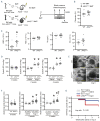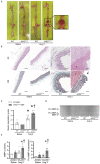Crucial role of hematopoietic JAK2 V617F in the development of aortic aneurysms
- PMID: 33567809
- PMCID: PMC8252954
- DOI: 10.3324/haematol.2020.264085
Crucial role of hematopoietic JAK2 V617F in the development of aortic aneurysms
Abstract
JAK2V617F is the most frequent driver mutation in myeloproliferative neoplasms (MPNs) and is associated with vascular complications. However, the impact of hematopoietic JAK2V617F on the aortic aneurysms (AAs) remains unknown. Our cross-sectional study indicated that 9 (23%) out of 39 MPN patients with JAK2V617F exhibited the presence of AAs. Next, to clarify whether the hematopoietic JAK2V617F contributes to the AAs, we applied a bone marrow transplantation (BMT) with the donor cells from Jak2V617F transgenic (JAK2V617F) mice or control wild-type (WT) mice into lethally irradiated apolipoprotein E-deficient mice. Five weeks after BMT, the JAK2V617F-BMT mice and WT-BMT mice were subjected to continuous angiotensin II infusion to induce AA formation. Four weeks after angiotensin II infusion, the abdominal aorta diameter in JAK2V617F-BMT mice was significantly enlarged compared to that in the WT-BMT mice. Additionally, the abdominal AA-free survival rate was significantly lower in the JAK2V617F-BMT mice. Hematopoietic JAK2V617F accelerated aortic elastic lamina degradation as well as activation of matrix metalloproteinase (MMP)-2 and MMP-9 in the abdominal aorta. The numbers of infiltrated macrophages were significantly upregulated in the abdominal aorta of the JAK2V617F-BMT mice accompanied by STAT3 phosphorylation. The accumulation of BM-derived hematopoietic cells carrying JAK2V617F in the abdominal aorta was confirmed by use of reporter GFP-transgene. BM-derived macrophages carrying JAK2V617F showed increases in mRNA expression levels of Mmp2, Mmp9, and Mmp13. Ruxolitinib decreased the abdominal aorta diameter and the incidence of abdominal AA in the JAK2V617F-BMT mice. Our findings provide a novel feature of vascular complications of AAs in MPNs with JAK2V617F.
Figures







Comment in
-
JAK out of the box: myeloproliferative neoplasms--associated JAK2 V617F mutations contribute to aortic aneurysms.Haematologica. 2021 Jul 1;106(7):1783-1784. doi: 10.3324/haematol.2020.277111. Haematologica. 2021. PMID: 33567815 Free PMC article. No abstract available.
Similar articles
-
Platelets and neutrophils cooperate to induce increased neutrophil extracellular trap formation in JAK2V617F myeloproliferative neoplasms.J Thromb Haemost. 2024 Jan;22(1):172-187. doi: 10.1016/j.jtha.2023.08.028. Epub 2023 Sep 9. J Thromb Haemost. 2024. PMID: 37678548
-
[Regulation of Ruxolitinib on matrix metalloproteinase in JAK2V617F positive myeloroliferative neoplasms cells].Zhonghua Xue Ye Xue Za Zhi. 2017 Feb 14;38(2):140-145. doi: 10.3760/cma.j.issn.0253-2727.2017.02.011. Zhonghua Xue Ye Xue Za Zhi. 2017. PMID: 28279039 Free PMC article. Chinese.
-
Deletion of Stat3 enhances myeloid cell expansion and increases the severity of myeloproliferative neoplasms in Jak2V617F knock-in mice.Leukemia. 2015 Oct;29(10):2050-61. doi: 10.1038/leu.2015.116. Epub 2015 May 18. Leukemia. 2015. PMID: 26044284 Free PMC article.
-
Thrombosis in myeloproliferative neoplasms with JAK2V617F mutation.Clin Appl Thromb Hemost. 2013 Jul-Aug;19(4):374-81. doi: 10.1177/1076029612453761. Epub 2012 Jul 23. Clin Appl Thromb Hemost. 2013. PMID: 22826442 Review.
-
Overview of Transgenic Mouse Models of Myeloproliferative Neoplasms (MPNs).Curr Protoc Pharmacol. 2017 Jun 22;77:14.40.1-14.40.19. doi: 10.1002/cpph.23. Curr Protoc Pharmacol. 2017. PMID: 28640953 Free PMC article. Review.
Cited by
-
Primary Arterial Hypertension and Drug-Induced Hypertension in Philadelphia-Negative Classical Myeloproliferative Neoplasms: A Systematic Review.Biomedicines. 2023 Jan 28;11(2):388. doi: 10.3390/biomedicines11020388. Biomedicines. 2023. PMID: 36830925 Free PMC article. Review.
-
Inflammatory crosstalk impairs phagocytic receptors and aggravates atherosclerosis in clonal hematopoiesis in mice.J Clin Invest. 2024 Nov 12;135(1):e182939. doi: 10.1172/JCI182939. J Clin Invest. 2024. PMID: 39531316 Free PMC article.
-
Ex vivo effect of JAK inhibition on JAK-STAT1 pathway hyperactivation in patients with dominant-negative STAT3 mutations.J Clin Immunol. 2022 Aug;42(6):1193-1204. doi: 10.1007/s10875-022-01273-x. Epub 2022 May 4. J Clin Immunol. 2022. PMID: 35507130
-
Blood-Based Epigenetic Markers of FKBP5 Gene Methylation in Patients With Dilated Cardiomyopathy.J Am Heart Assoc. 2021 Nov 2;10(21):e021101. doi: 10.1161/JAHA.121.021101. Epub 2021 Oct 29. J Am Heart Assoc. 2021. PMID: 34713710 Free PMC article.
-
Clonal Hematopoiesis and the Heart: a Toxic Relationship.Curr Oncol Rep. 2023 May;25(5):455-463. doi: 10.1007/s11912-023-01398-1. Epub 2023 Mar 15. Curr Oncol Rep. 2023. PMID: 36920637 Free PMC article. Review.
References
-
- Kutti J, Ridell B. Epidemiology of the myeloproliferative disorders: essential thrombocythaemia, polycythaemia vera and idiopathic myelofibrosis. Pathol Biol (Paris). 2001;49(2):164-166. - PubMed
-
- Barbui T, Finazzi G and Falanga A. Myeloproliferative neoplasms and thrombosis. Blood. 2013;122(13):2176-2184. - PubMed
-
- De Stefano V, Ghirardi A, Masciulli A, et al. . Arterial thrombosis in Philadelphia-negative myeloproliferative neoplasms predicts second cancer: a case-control study. Blood. 2020;135(5):381-386. - PubMed
Publication types
MeSH terms
Substances
LinkOut - more resources
Full Text Sources
Other Literature Sources
Medical
Miscellaneous

